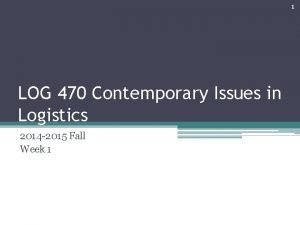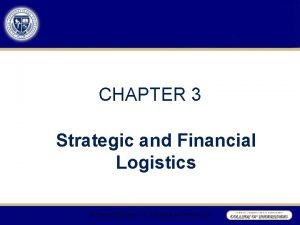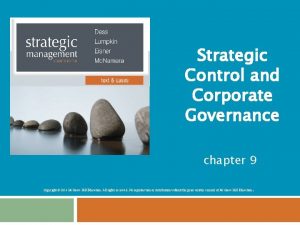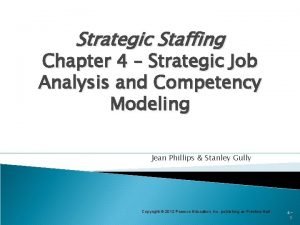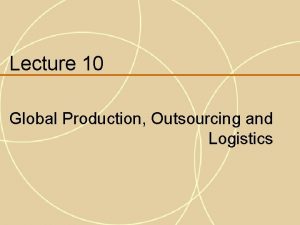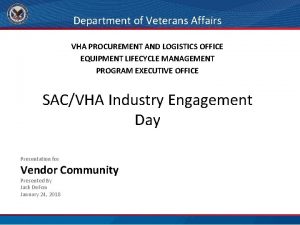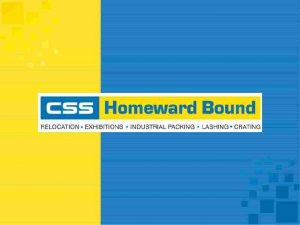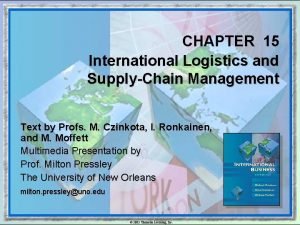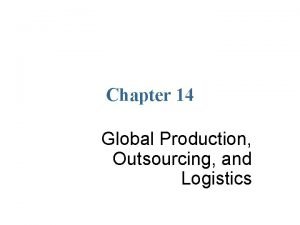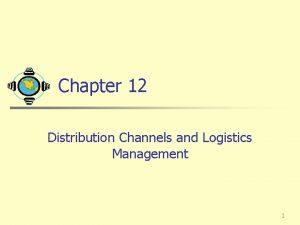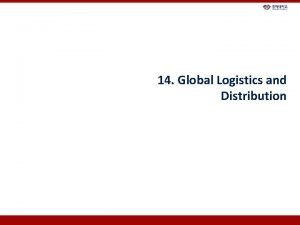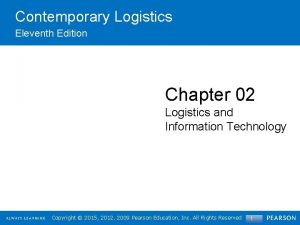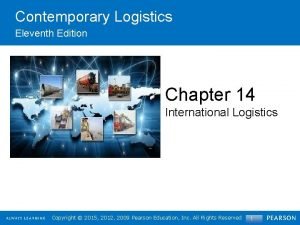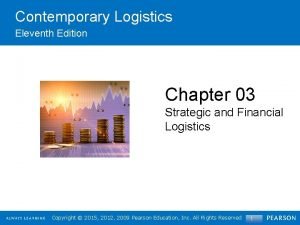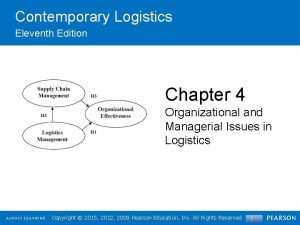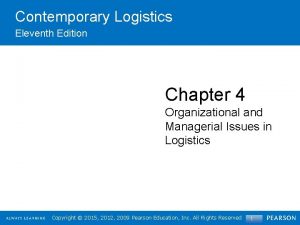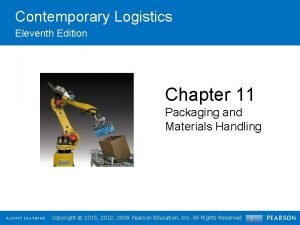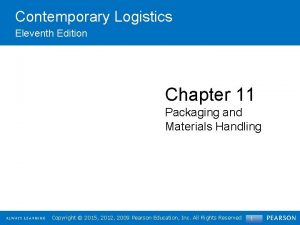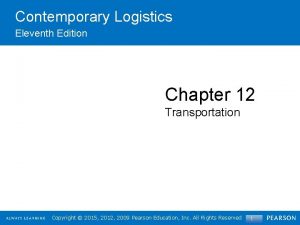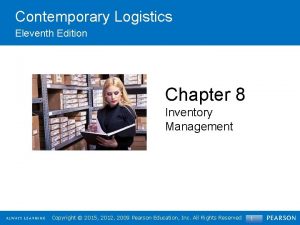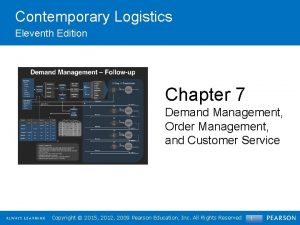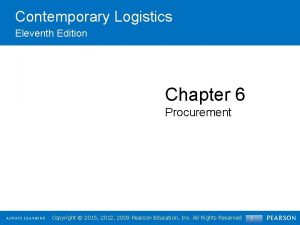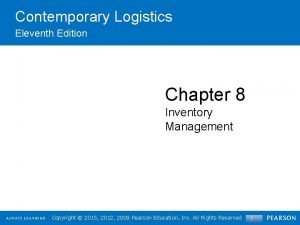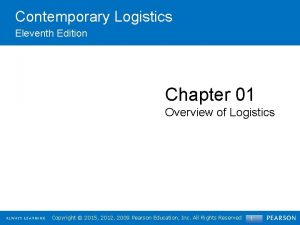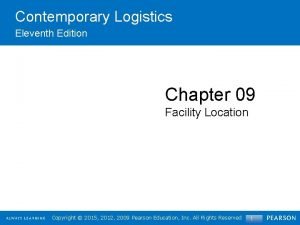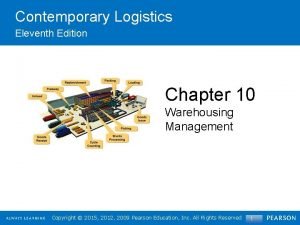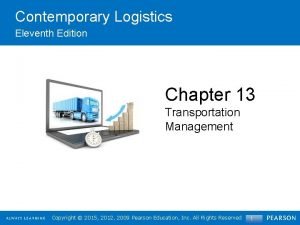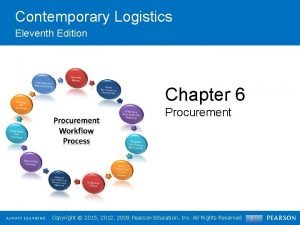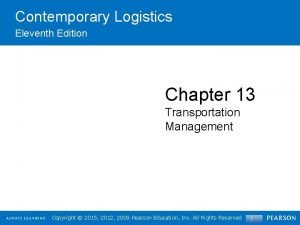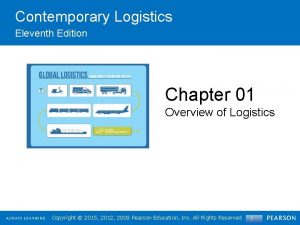Contemporary Logistics Eleventh Edition Chapter 03 Strategic and































- Slides: 31

Contemporary Logistics Eleventh Edition Chapter 03 Strategic and Financial Logistics Copyright©© 2015, 2012, 2009 Pearson. Education, Inc. All. Rights. Reserved Copyright 1

Strategic and Financial Logistics Key Terms • Assets • Income statement • Asset turnover • Liabilities • Balanced scorecard (BSC) • Net profit margin • Balance sheet • Owner’s equity • Cost leadership strategy • Return on assets (ROA) • Current ratio • Revenues (sales) • Differentiation strategy • Strategic Profit Model (SPM) • Expenses (costs) • Focus strategy Copyright © 2015, 2012, 2009 Pearson Education, Inc. All Rights Reserved 2

Learning Objectives • To appreciate how logistics can influence an organization’s strategic financial outcomes • To review basic financial terminology • To understand how the strategic profit model can demonstrate the financial impact of logistics activities • To consider the value of utilizing the balanced scorecard approach for examining the performance of a logistics systems • To become aware of some of the more common performance measures for logistics activities Copyright © 2015, 2012, 2009 Pearson Education, Inc. All Rights Reserved 3

4 Overview of Class • Chapter 3 • In-Class Activities (seen on pwpt) – Participation Copyright © 2015, 2012, 2009 Pearson Education, Inc. All Rights Reserved 4

News and Books • Supply Chain Brian • Good Read: – " Discover how your supply chain and operations work impacts financial performance, and how to align your efforts to help your company succeed – the fastest, best way to supercharge your own career! As a supply chain or operations professional, you may clearly understand your operational performance goals. But if you want to get promoted, you need to know how your day-to-day work powerfully impacts the financial metrics your top executives care about most. 2015 Cengage Learning Copyright © 2015, 2012, 2009 Pearson©Education, Inc. All Rights Reserved 5

Connecting Strategy to Financial Performance (1 of 8) • Logistics managers must find ways to: • communicate how logistics capabilities provide value • support corporate strategy and success in financial terms. • Logistics resides at the functional level of the organization. • Functional units must translate corporate and business unit strategies into discrete action plans. Copyright © 2015, 2012, 2009 Pearson Education, Inc. All Rights Reserved 6

Connecting Strategy to Financial Performance (2 of 8) • Three generic strategies that can be pursued by an organization 1. Cost leadership strategy • Requires an organization to pursue activities that will enable it to become the low-cost producer in an industry for a given level of quality 2. Differentiation strategy • Entails an organization developing a product and/or service that offers unique attributes that are valued by customers and that the customers perceive to be distinct from competitor offerings Copyright © 2015, 2012, 2009 Pearson Education, Inc. All Rights Reserved 7

Connecting Strategy to Financial Performance (3 of 8) • Three generic strategies that can be pursued by an organization 3. Focus strategy • Concentrates an organization’s effort on a narrowly defined market to achieve either a cost leadership or differentiation advantage Copyright © 2015, 2012, 2009 Pearson Education, Inc. All Rights Reserved 8

Connecting Strategy to Financial Performance (4 of 8) • Functional level strategies exist in: • Marketing • Finance • Manufacturing • Procurement • Logistics Copyright © 2015, 2012, 2009 Pearson Education, Inc. All Rights Reserved 9

Connecting Strategy to Financial Performance (5 of 8) • Logistic strategy decisions involve: • Determining the number and location of warehouses • Selecting appropriate transportation modes • Deploying inventory • Investments in technology that support logistics activities Copyright © 2015, 2012, 2009 Pearson Education, Inc. All Rights Reserved 10

Connecting Strategy to Financial Performance (6 of 8) • Logistics strategy is directly influenced by strategic decisions in functional areas of: • Marketing • Product availability, desired customer service levels, and packaging design directly influence logistics decisions • Finance • Rates of return may affect the decision to manager one’s own warehouse or use a third-party provider Copyright © 2015, 2012, 2009 Pearson Education, Inc. All Rights Reserved 11

Connecting Strategy to Financial Performance (7 of 8) • Logistics strategy is directly influenced by strategic decisions in functional areas of: • Manufacturing • Strategic decisions by manufacturing to implement just -in-time system would influence logistics decisions in warehousing, transportation and inventory management • Procurement • The decision to move from domestic to global sourcing would naturally affect logistics activities such as the potential use of new modes of transportation Copyright © 2015, 2012, 2009 Pearson Education, Inc. All Rights Reserved 12

Connecting Strategy to Financial Performance (8 of 8) • Logistics function can positively affect the financial outcome of an organization by designing a strategy to optimally support the requirement of the business. Copyright © 2015, 2012, 2009 Pearson Education, Inc. All Rights Reserved 13

Basic Financial Terminology (1 of 4) • Income statement shows for a period of time: • Revenues • Also referred to as sales, provide a dollar value of all the products and/or services provided by a company • Expenses • Also referred to as costs, provide a dollar value for the costs incurred in generating revenues during a given period of time • Profit • Also referred to as a profit and loss (P&L) statement Copyright © 2015, 2012, 2009 Pearson Education, Inc. All Rights Reserved 14

Basic Financial Terminology (2 of 4) Figure 3. 1: Example Income Statement 2012 Empty $200, 000 Empty $130, 000 Empty $70, 000 Transportation cost $6, 000 Empty Warehousing cost $3, 000 Empty Inventory carrying cost $1, 000 Empty Other operating $30, 000 Empty Total operating cost $40, 000 Empty $30, 000 Interest Empty $11, 000 Taxes Empty $6, 000 Empty $13, 000 Sales Cost of goods sold Gross Margin Earnings Before Interest and Taxes Net income Copyright © 2015, 2012, 2009 Pearson Education, Inc. All Rights Reserved 15

Basic Financial Terminology (3 of 4) • Balance sheet reflects at any given point in time: • Assets • What a company owns and come in two forms: current assets that can be easily converted to cash and longterm assets that have a useful life of more than one year • Liabilities • The financial obligations a company owes to another party • Owner’s equity • Difference between what a company owns and what it owes a any particular point in time Copyright © 2015, 2012, 2009 Pearson Education, Inc. All Rights Reserved 16

Basic Financial Terminology (4 of 4) Figure 3. 2: Example Balance Sheet 2012 Empty Assets Cash $20, 000 Accounts receivable $35, 000 Inventory $15, 000 Total current assets $70, 000 Net fixed assets $80, 000 Total assets $150, 000 Liabilities Current liabilities $60, 000 Long-term debt $30, 000 Total liabilities $90, 000 Shareholder’s Equity $60, 000 Total Liabilities and Equity $150, 000 Copyright © 2015, 2012, 2009 Pearson Education, Inc. All Rights Reserved 17

Strategic Profit Model (1 of 5) • Issues with reporting financial figures without appropriate context • Many financial measures reported as ratios • Profitability analysis is useful in assessing logistics activities and proposed changes to a firm’s logistical systems • Return On Investment (ROI) is a common measure of organizational financial success Copyright © 2015, 2012, 2009 Pearson Education, Inc. All Rights Reserved 18

Strategic Profit Model (2 of 5) • Return On Net Worth (RONW) measures profitability of funds invested in the business • Return On Assets (ROA) provides insight on how well managers utilize operational assets to generate profits • Return On Investment (ROI) • common measure of organizational financial success • Return On Net Worth (RONW) • measures profitability of funds invested in the business Copyright © 2015, 2012, 2009 Pearson Education, Inc. All Rights Reserved 19

Strategic Profit Model (3 of 5) • Return On Assets (ROA) • Indicates what percentage of every dollar invested in the business is ultimately returned to the organization as profit • Strategic Profit Model (SPM) • provides the framework for conducting ROA analysis • Incorporates revenues and expenses to generate net profit margin • Includes assets to measure asset turnover Copyright © 2015, 2012, 2009 Pearson Education, Inc. All Rights Reserved 20

Strategic Profit Model (4 of 5) Figure 3. 3: Strategic Profit Model Copyright © 2015, 2012, 2009 Pearson Education, Inc. All Rights Reserved 21

Strategic Profit Model (5 of 5) • Strategic Profit Model (SPM) • Provides a way for managers to examine how a proposed change to their logistics system influences profit performance and ROA • Fails to: • Consider the timing of cash flows • Subject to manipulation in the short run • Fails to recognize assets dedicated to specific relationships Copyright © 2015, 2012, 2009 Pearson Education, Inc. All Rights Reserved 22

Logistics Connections to Net Profit Margin (1 of 2) • Net Profit Margin = net profit/sales • Multiple ways in which net profit margin can be influenced by managerial decisions • Relevant categories include: • Sales • Cost of goods sold • Total expenses Copyright © 2015, 2012, 2009 Pearson Education, Inc. All Rights Reserved 23

Logistics Connections to Net Profit Margin (2 of 2) • Sales • The dollar value of all the products or services an organization provides to its customers during a given period of time • Cost of goods sold • Includes all the costs or materials and labor directly involved in producing a product or delivering a service • Total expenses • Made up of the variable and fixed costs that are not directly related to making the product or delivering a service Copyright © 2015, 2012, 2009 Pearson Education, Inc. All Rights Reserved 24

Logistics Connections to Asset Turnover (1 of 2) • Asset turnover= total sales/total assets • Asset turnover provides information on how efficiently capital is employed to support the business • Inventory is typically the most relevant logistics asset • Logistics decisions can influence the speed at which invoices are paid – accounts receivable Copyright © 2015, 2012, 2009 Pearson Education, Inc. All Rights Reserved 25

Logistics Connections to Asset Turnover (2 of 2) • Inventory can represent a significant part of a firm’s current assets • Accounts receivable is the amount of money customers owe to an organization Copyright © 2015, 2012, 2009 Pearson Education, Inc. All Rights Reserved 26

Balanced Scorecard (1 of 2) • Balance scorecard (BSC) is a strategic planning and performance management system used in industry, government, and nonprofit organizations. Copyright © 2015, 2012, 2009 Pearson Education, Inc. All Rights Reserved 27

Balanced Scorecard (2 of 2) • Management should evaluate their businesses from four perspectives • Customers • Internal business processes • Learning and growth • Financial results • Forces managers to look beyond traditional financial measures (more holistic approach) Copyright © 2015, 2012, 2009 Pearson Education, Inc. All Rights Reserved 28

Logistics Activity Measures (1 of 2) • Transportation measures • Focus on labor, cost, equipment, energy and transit time • Warehousing measures • Include labor, cost, time, utilization and administration • Inventory measures • Include obsolete inventory, inventory carrying cost, inventory turnover and information availability Copyright © 2015, 2012, 2009 Pearson Education, Inc. All Rights Reserved 29

Logistics Activity Measures (2 of 2) • Design and Implementation of Measures • Determination of key measures should be tailored to the organization and level of decision making • Data collection and analysis are a major part of a performance measurement system in logistics • Behavioral issues should be considered when establishing and implementing a system of logistics measures • Frequent communication and constant updating of the measures is a necessary condition for ensuring they are supporting organizational goals Copyright © 2015, 2012, 2009 Pearson Education, Inc. All Rights Reserved 30

31 Next Week • Chapter 4 Copyright © 2015, 2012, 2009 Pearson Education, Inc. All Rights Reserved 31
 Management eleventh edition stephen p robbins
Management eleventh edition stephen p robbins Eleventh edition management
Eleventh edition management Management eleventh edition
Management eleventh edition Management eleventh edition stephen p robbins
Management eleventh edition stephen p robbins Bhore committee
Bhore committee Eleventh 5 year plan
Eleventh 5 year plan Thfive
Thfive For his eleventh birthday elvis presley
For his eleventh birthday elvis presley Contemporary issues in logistics
Contemporary issues in logistics Strategic and financial logistics
Strategic and financial logistics Grant strategic management
Grant strategic management Informational and behavioral control
Informational and behavioral control Strategic substitute
Strategic substitute Strategic competitiveness
Strategic competitiveness Tows matrix
Tows matrix Using mis 10th edition
Using mis 10th edition Zulily case study
Zulily case study Strategic staffing 4th edition pdf free download
Strategic staffing 4th edition pdf free download Strategic fit vs strategic intent
Strategic fit vs strategic intent Infants children and adolescents 8th edition
Infants children and adolescents 8th edition Value chain and supply chain difference
Value chain and supply chain difference Global production, outsourcing, and logistics
Global production, outsourcing, and logistics Oxid wms
Oxid wms Crm supply chain
Crm supply chain Vha procurement and logistics office
Vha procurement and logistics office Homeward bound moving solutions and logistics
Homeward bound moving solutions and logistics International logistics and supply chain outsourcing
International logistics and supply chain outsourcing Global production outsourcing and logistics
Global production outsourcing and logistics Distribution channel and logistics
Distribution channel and logistics Global logistics and distribution
Global logistics and distribution Vocational education uae
Vocational education uae Third party vs fourth party
Third party vs fourth party








